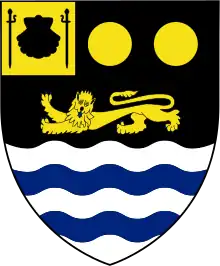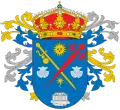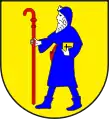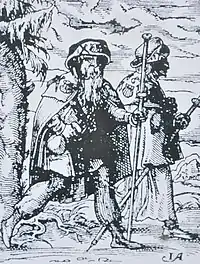Pilgrim's staff
The pilgrim's staff is a walking stick used by Christian pilgrims during their pilgrimages, like the Way of St. James to the shrine of Santiago de Compostela in Spain or the Via Francigena to Rome. In Rome, in the Middle Ages the pilgrims used to leave their stick in the church of San Giacomo Scossacavalli (not far from St. Peter), whose first denomination was San Salvatore de Bordonia, where Bordone is the Italian word for Stick.[2][3] After that, they bought a new stick by sellers named Vergari (verga is another term for stick), whose shops were in today's Borgo Santo Spirito near the church of Santa Maria dei Vergari.[4]

Background
Generally, the stick has a hook on it so that something may be hung from it. The walking stick sometimes has a cross piece on it.[5] The pilgrim's staff has a strong association with the veneration of Saint James the Great and the pilgrimage to Santiago de Compostela.
The pilgrim's staff is also a heraldic device.[5]
Gallery
 Coat of Arms of Cangas, Galicia
Coat of Arms of Cangas, Galicia Pilgrim's staff
Pilgrim's staff Coat of Arms of Bever featuring pilgrim with pastoral staff
Coat of Arms of Bever featuring pilgrim with pastoral staff Way of St. James pilgrims (1568)
Way of St. James pilgrims (1568)
References
- Gigli (1992) p. 8
- Borgatti (1926) p. 156
- Borgatti (1926) p. 51
- Pilgrim's or Palmer's Staff, (fr. bourdon): this was used as a device in a coat of arms as early at least as Edward II.'s reign, as will be seen. The Staff and the Escallop shell(q.v.) were the badge of the pilgrim, and hence it is but natural it should find its way into the shields of those who had visited the Holy Land. The usual form of representation is figure 1, but is some the hook is wanting, and when this is the case it is scarcely distinguishable from a pastoral staff as borne by some of the monasteries: it is shown in figure 2. While, too, it is represented under different forms, it is blazoned as will be seen also, under different names, e.g. a pilgrim's crutch, a crutch-staff, &c., but there is no reason to suppose that the different names can be correlated with different figures. The crutch, perhaps, should be represented with the transverse piece on the top of the staff (like the letter T) instead of across it. heraldsnet.org